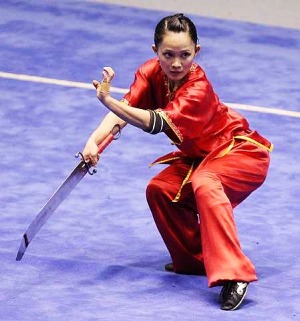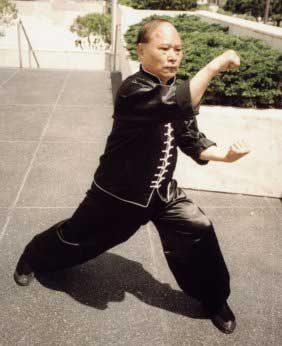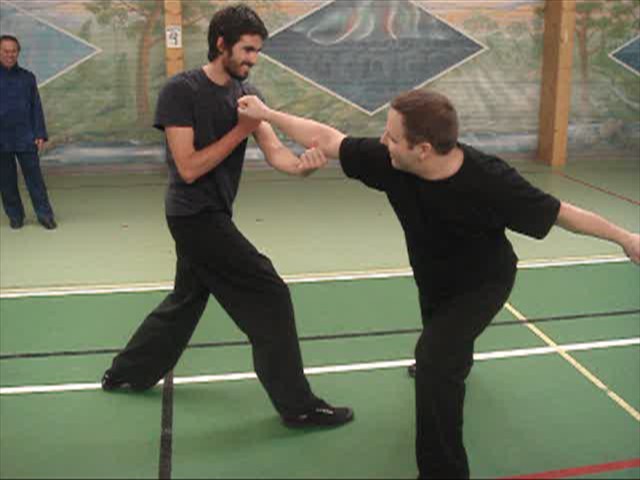CLEARING THE CONFUSION OVER KUNGFU, WUSHU AND SELF-DEFENCE

A modern wushu pattern demonstrated by a wushu champion. The picture is reproduced from http://martialarts.com.my/community/modules/news/article.php?storyid=1834
Question
I live in a small city where there are not any very good instructors who teach martial arts. In my kungfu school, which is the only one that teaches wushu in my city, we never really spar. We do mostly forms and drills. Do you think this is the proper way to learn kungfu and learn how to defend myself?
— Jeff, Canada
Answer
There has been quite a lot of confusion between kungfu and wushu, and the main reasons are as follows. In the Chinese language, the current technical term for martial art is “wushu”, although many Chinese, especially overseas Chinese, colloquially call it “kungfu”, which is also the term commonly used in the West.
Secondly, since the 1970s, the Chinese government has promoted wushu as a sport and not a martial art. Today there are many wushu teachers, Chinese as well as non-Chinese, teaching this sport all over the world.
Thirdly, some kungfu schools which have existed outside China before modern wushu was invented in China, now also teach modern wushu besides traditional kungfu. The standard of traditional kungfu in these schools is generally low, usually without training in internal force or sparring. In essence, in these schools there is not much difference between “kungfu” and “wushu”. The difference is in appearance, and is easily noticeable. By “kungfu” they usually mean traditional kungfu forms, by “wushu” they mean modern forms invented since 1970s.
Apart from these three points, there is another aspect which is more subtle or subjective, and can be quite sensitive. To me, kungfu is a martial art. So, if someone practices traditional kungfu forms, as distinct from modern wushu forms, but does not know how to use his art for combat, I would not call it kungfu. This is a minority opinion. The majority still call it “kungfu” even if it is devoid of any martial application.
Sometimes I use the term “genuine kungfu” or “real kungfu” to differentiate kungfu that is capable of combat application from “kungfu” that is devoid of combat application. I also use terms like “external kungfu forms” or “kungfu gymnastics” to refer to the latter. These terms are not ideal and sometimes cause resentment but I could not think of better terms.

A traditional kungfu pattern demonstrated by a kungfu master. The picture is reproduced from http://www.ycwong-italy.com/forms.htm
This background information explained above, can help to overcome much confusion and help to solve many arguments over kungfu and wushu. For example, one person may argue that all kungfu is wushu, and another person may vehemently oppose. Both persons are right from their own different pers;pectives. The first person argues from the perspective that the Chinese word for kungfu is “wushu”, whereas the second person argues from the perspective that kungfu is a martial art but wushu is a sport.
Reversely, one person may argue that what he practices is kungfu, whereas another may argue that it is wushu. The first person argues from the perspective that his forms are traditional, whereas the second argues that although the forms are different in appearance from modern wushu forms, they are practiced not as a martial art but as a sport and therefore in essence is modern wushu.
Today many schools only practice forms and drills, and never spar — irrespective of whether they teach only traditional kungfu forms, or only modern wushu forms, or both traditional kungfu and modern wushu forms together. This is the norm.
Those schools that teach only traditional kungfu forms, as well as those that teach both traditional kungfu and modern wusshu forms are usually called kungfu schools, whereas those that teach modern wushu forms are usually called wushu schools — if we refer to them in English.
If we refer to them in Chinese, all of them are usually called “wushu” schools, including those that practice traditional kungfu forms, and even if they use genuine kungfu for sparring. This is the de-facto situation, and sometimes causes confusion. My school, for example, is “Shaolin Wahnam Kungfu Institute” in English, but “Shao Lin Hua Nan Wu Shu Guan” (Cantonese: “Siu Lam Wah Nam Mo Shert Kwoon”) in Chinese.
If you mostly practice forms and drills, no matter how long you may practice them and how beautiful your solo performance may be, and irrespective of whether they are traditional kungfu forms and drills or modern wushu forms and drills, you will not be able to defend yourself if you have never learnt sparring methodically. Although this is the norm, in my opinion it is certainly not the correct way to learn kungfu (as a martial art) and learn how to defend yourself.
Anyone, master or novice, who has never learnt to spar, will be unable to spar or fight effectively. This is only logical. This is as logical as anyone who has never learnt how to speak Spanish (although he may know the meanings of written Spanish words) will be unable to speak Spanish, or anyone who has never learnt how to drive a car (although he may have read many driving manuals) will be unable to drive a car.

Irrespetive of whether you practice traditional kungfu or modern wushu, unless you also learn combat application systematically, you would not be able to use it to fight
LINKS
Reproduced from Questions 11 in the January 2003 Part 1 issue of the Question-Answer Series.
